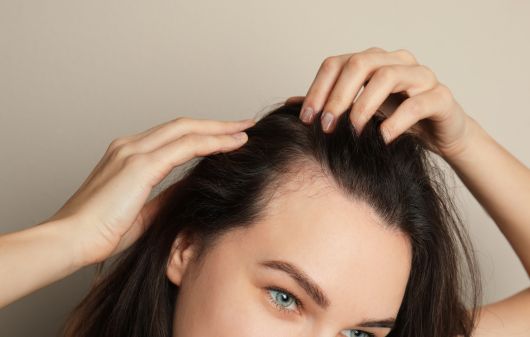
Get hair loss treatment and prescriptions online
Baldness, also known as alopecia, is the loss of hair, usually on the scalp, but can occur anywhere on the body where hair grows. It can result from aging, hormonal changes, heredity, or medical conditions.
Hereditary hair loss is one of the common causes of baldness. Various treatments are available to prevent further loss or stimulate regrowth. Consult a doctor at Your Doctors Online to identify the cause, discuss treatment options, and get a well-suited prescription.
What is hair loss?
Hair loss is a medical condition also known as alopecia in medical terms. Usually, it affects the scalp and head, but other body parts can also be affected by this condition depending on the cause and where it affects.
There could be a number of causes for alopecia and hair loss, ranging from hereditary causes, stress, psychological reasons, any medical condition, deficiencies, poor diet, hormonal problems, and drug use. Causes vary from person to person, and so do the treatment options.
What are the other symptoms associated with hair loss?
Hair loss itself is a symptom. Some of the other associated symptoms along with hair loss in alopecia patients are as follows:
- Scalp itching or irritation
- Thinning of hair
- Bald patches or areas of hair loss
- Changes in hair texture or quality
- Scalp tenderness or pain
- Redness or inflammation of the scalp
- Flaky or scaly scalp (dandruff)
- Changes in nail texture or quality (rarely)
The causes, symptoms, and treatment options vary in population.
What are the causes of hair loss?
Some of the scientifically proven causes of hair loss include:
- Genetic factors
- Vitamin and mineral deficiencies
- Skin problems
- Hair growth disorders
- Poor diet
- Hormonal problems
- Internal diseases
- Drug use
- Stress
- Depression
- Cosmetic factors
- Childbirth
- Chemotherapy process.

What are the treatment options for hair loss?
Effective treatment options for hair loss depend on an individual’s cause of hair loss. Some of the most recommended treatment options include:
- Medications: If hair loss is due to an underlying disease, addressing the cause is necessary.
- Medications like minoxidil and finasteride can treat pattern baldness.
- Topical minoxidil stimulates hair growth and prevents further loss
- Finasteride, a daily pill, slows hair loss and promotes regrowth.
- Corticosteroid injections are also widely recommended for treating hair loss.
- Surgeries: Hair transplant surgeries redistribute hair from one part of the head to bald areas.
- Laser therapy
- Microneedling therapy
- Platelet-rich plasma (PRP).
If genetic factors are the major contributors to baldness and hair loss, the treatment options will depend on the individual condition.
Hair loss medication we prescribe
How to connect with doctor for hair loss
Connect with a health care professional online in 3 easy steps.
1
Describe your issue
Download our app, register and tell us about your medical issue to get started.
- Baldness
- Anemia
- STD
- UTI
- Skin
- Covid
2
Chat with a doctor
Connect with a board-certified doctor. You can chat, send pictures and videos.
Hi Dr. Nicole, I have bald patches on my scalp. Can you help me?
3
Get prescription
Our online doctors can help you with your medical issues and give you prescriptions.
Prescription
- Minoxidil 5%
- Apply on a dry scalp twice a day for four months
Send Prescription
How to prevent hair loss?
Hair loss can only be prevented if caused by external factors; if not, it needs proper consultation for a well-suited and tailored prescription and treatment options.
Hair loss from external or environmental factors can be prevented by:
- Maintain a balanced diet rich in protein, vitamins (especially vitamins A, C, D, and E), and minerals (such as iron and zinc).
- Avoid hairstyles that pull on the hair, such as tight ponytails or braids.
- Use gentle hair care products and avoid excessive heat styling or chemical treatments.
- Keep the scalp clean and healthy by washing regularly with a mild shampoo.
- Manage stress through relaxation techniques, exercise, or hobbies.
- Avoid smoking and limit alcohol consumption.
- Protect hair from sun damage by wearing a hat or using sunscreen specifically designed for hair.
- Consider using products containing minoxidil or finasteride under medical supervision for certain types of hair loss.
FAQs about hair loss
What are the most effective treatments for addressing baldness?
Baldness can be treated with medications that boost hair growth and stop hair loss or at least slow it. For example, the most effective ones are minoxidil and finasteride. Each drug works differently for men and women therefore, dosages and administration may vary slightly.
What options are available for treating female pattern baldness?
For the treatment of female pattern baldness, doctors prescribe minoxidil, hormone therapy, or hair transplant in some cases. Proper nutrition intake is vital for the treatment to work and promote hair growth faster.
What's the best approach to treating male pattern baldness?
The specific oral medication a doctor prescribes to male patients is finasteride, which increases the testosterone level, whose imbalance can be a potential reason for baldness. Consult our doctors at Your Doctors Online for treating and prescribing male pattern baldness.
How much hair loss is normal?
Usually, 50-100 strands of hair loss in a day is considered normal, and one should not be worried about it. If one notices more than that, consult a healthcare provider or dermatologist for an effective diagnosis and treatment options for excessive hair loss.
Which vitamin deficiency causes hair loss?
Vitamin B12 deficiency in the body leads to related problems like hair loss and grayish hair, even at a young age. Consult your dermatologist for effective management options.
Does leukemia cause hair loss before treatment?
Usually, hair loss is observed after the treatment for leukemia starts but not before the treatment.
Does radiation treatment cause hair loss?
Yes, It can. Radiation treatment is given as the treatment for cancer affecting hair growth and stability. Radiation can affect your hair and cause drastic hair loss as well.
Does valacyclovir cause hair loss?
You might experience hair loss with valcyclovir treatment. Although it's not mentioned in the side effects, the FDA has mentioned hair loss as a possible side effect of valcyclovir.
How long does it take to see results from baldness treatments?
Baldness treatments may show results slower in some individuals than others. Mostly, the recovery depends upon the underlying cause. In case of hormonal imbalances, hormone therapy can restore the loss. If the cause is a side effect of a disease, treatment of the disease is essential to restore the loss. In some cases, it can be genetic and environmental triggers. It takes 3-6 months for the hair to respond.
What role does hormonal imbalance play in baldness, and how can it be treated?
Hormonal imbalance plays a role in baldness, especially in females during transition periods like postpartum hair loss or menopause when hormonal changes are frequent. It causes hair loss, which can be treated with hormonal therapy to balance the hormones and restore hair growth.
-Phindile Mkhatshwa
-brooke snow
-Okiti Stephanie
-ASIF Khan
-Chelsey
-edith bien aime
-Lesego Thejane
-Stephanie Brown
-kulwinder gill
-Elijah Mark
Get started today
Talk to online doctors now and get medical advice, online prescriptions, refills, lab requisitions and medical notes within minutes. On-demand healthcare services at your fingertips.





